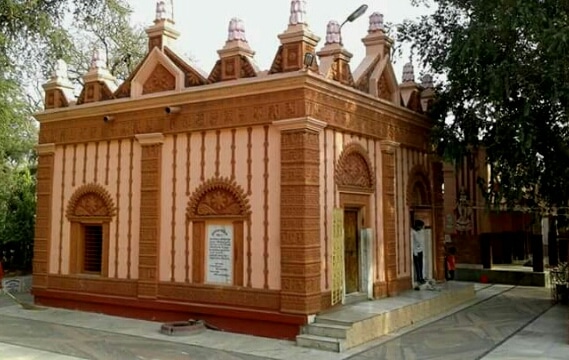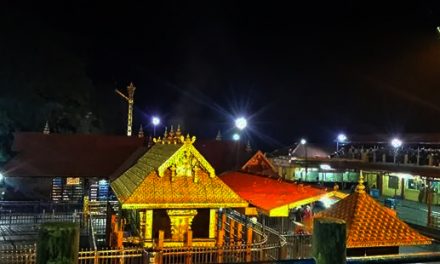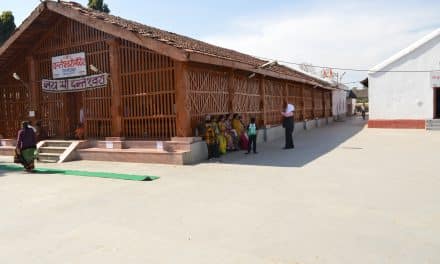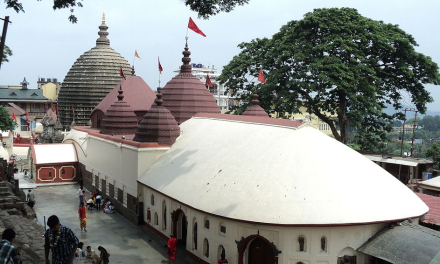Fullora is a temple town where Devi Mata Adi Shakti resides and being worshipped as ‘Phullora’ or ‘Fullora'(bearing with its meaning ‘Flowering’ or ‘Blooming’) for centuries and named after the town. The temple where the goddess is sedentary has familiarised its devotees and tourists as ‘Attahas Temple’ or ‘Attahasa Temple'(laughter). Here the beloved consort of Devi Mata, Lord Shiva, is also being worshipped as ‘Vishwesh'(Lord of the universe) for centuries.
This beautiful shrine is located by the bank of the River Ishani inside the village Dakshindihi, whereas ‘Fullora’ has its administrative designation on the east of Labhpur CD Block in Bolpur subdivision of Birbhum district in West Bengal, India.
Once upon a time, a pond was laid just by the side of the idol, which is not visible now. As per legend, Pavanputra ‘Hanuman'(the son of the Hindu God ‘Air’) appeared once(in Treta Yuga, called as ‘Triads’) to this pond to pick up 108 blue lotuses to worship Devi Durga performed by Lord Rama(the 7th incarnation of Lord Vishnu).
Legends associated with this temple
This Shakti Peeth bears the same mythological, and religious event of Hindu Scripture featured in ‘Daksha-Yajna’ by Devi Sati, Lord Shiva, King Daksha and finally Lord Vishnu with others. This enchanting, as well as tragic event, is based on the foundation of the fifty-one Shakti Peethas, oriented in the sub-continent. King Daksha organised a yajna(sacrificial religious ritual) in which he invited all the dignitaries’ peers to him except his younger daughter ‘Sati’ and son-in-law ‘Lord Shiva’ deliberately. Initially, King Daksha was a devotee of ‘Trimurthys'(Brahma, Vishnu and Shiva), whereas he was amidst a misconception about an incident committed by his father, Prajapati Brahma. On the other hand, he came to know that his younger daughter ‘Sati’ fell in love with Lord Shiva and also knew how Lord Shiva led a modest life with his companions. As King Daksha came from a royal family and his younger daughter also, he became angry with his daughter as well as Lord Shiva. King Daksha tried his best but failed to make his daughter understand. So, his younger daughter ‘Sati’ was insistent on marrying Lord Shiva, and She did so against Her father’s will. However, Devi Sati insisted Her consort, Lord Shiva, attend the yajna. Lord Shiva dissuaded Her, but She did not obey Him. Being uninvited, Devi Sati had to accept a lot of slang rushed toward Her consort amidst the occasion.
Devi Sati tried to make Her father calm down, but She failed, and humiliation towards Her as well as Her beloved culminated, so She was compelled to curse Her father and got self-immolated into the same sacrificial altar. As a result, She got burnt. The onlookers tried heart and soul to rescue Her alive, but it was their misfortunes that they were only able to pull out Her burnt corpse. Lord Shiva was informed of this mishap, and He became both sorrowful and rageful with this. He appeared to the venue at a glance and demolished all the things there were and took the burnt corpse of His better half onto His strong shoulders, and took a moment to start His ‘Tandava’ or ‘Bhairava Nritya'(the dance of destruction) to bring the universe under destruction. To calm down Lord Shiva and to save the universe from assured destruction, Lord Vishnu was bolded with the help of His ‘Sudarshan Chakra'(disc of auspicious vision) to mutilate the burnt corpse of Devi Sati. With this chakra, the corpse was dismembered into fifty-one pieces and fell to the earth. It is a hearsay that the ‘lower lip’ of Devi Sati fell here to make the place holy and was established one of fifty-one ‘Shakti Peethas’ later.
Architectural eminence and accommodation
Devi Sati’s consort, Lord Shiva, is sitting on a lotus, which has been created adjacent to the temple complex, whereas there is not any traditional proper idol or image of the goddess which is installed inside the sanctum sanctorum. In spite of all this, a large size stone of 15 feet to 18 feet wide, smeared with vermilion, has been settled down inside the holy place, which carries a familiar mythological significance. Though the temple does not have any grandeur ornamentation, its adornment with marble has established this temple like the spottiest architecture and made this edifice attractive to the onlookers. Since this temple is very ancient, it carries various gods and goddesses embossed on the walls and pillars of it, along with some shlokas(hymns).
Daily worshipping and festivals
Devi ‘Fullara or Phullora’ and Her Bhairav ‘Lord Vishwesh’ both are offered worshipping and aarti(subjugation) both in the morning as well as in the evening daily with ‘anna bhoga'(rice) with devotion. Offerings that are made to the god and goddess are usually grown from the soil.
Magh Purnima is an auspicious day, celebrated here with grandeur, and a ten-day fair is organised on this occasion near ‘Fullara Temple’, which is also renowned as ‘Phullora Mela’, pulls thousands of tourists to Labhpur during the end of winter. Apart from this, ‘Navratri’ is another festivity which is also celebrated here between the month of September to October. During this festival, both the possessors here are worshipped, especially for the nine days, and special ceremonies(Navratri fair for nine days) are also performed here. A custom not to take anything grown under land is practised by some locals during this festival.
Temple Timing: Devotees may be blessed by taking their darshan(visiting) from 6:00 a.m. to 10:00 p.m., and during this time, they can also offer their pujas(worshippings) to the Almighty.
Dress Code: Women are allowed into the temple premises in clear sarees, whereas men are permitted to enter therein in dhoti or pyjama along with a kurta.
How to reach: This temple has its distance from Bolpur-Shantiniketan by 30 km, from Birbhum to Ahmedpur to Labhpur the distance is 6.5 miles(10.4 km) and from Netaji Shubhash Chandra International Airport to Labhpur has the distance by 184 km to 196 km. Labhpur is the nearest railway station(3 km) from the temple, but it is a small station where rare Express trains and only some Passenger trains stop here. So, the nearest Junction station is Ahmedpur(about 13.1 km) to the temple. From here, one can hire local transport to reach the temple. ‘Nirol Bus Stand’ is the nearest bus stand (5 km) from the temple.
Image courtesy: Pinakpani
















